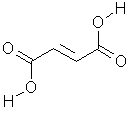Ingredients --
Fumaric acid
Chemical Formula:

Synonyms
allomaleic acid,
2-butenedioic acid,
trans-butenedioic acid,
boletic acid,
lichenic acid,
trans-1,2-ethenedicarboxylic acid
Description
Colorless crystals or white powder.
Uses
Fumaric acid is used as a flavoring, because it is the sourest
tasting of the organic acids. Three parts of fumaric acid are
as sour as five parts of citric acid.
It is also used as an anti-oxidant, as a
mordant (a
substance that helps dyes stick to fabric), and as a buffering
agent (helps maintain a particular acidity or alkalinity).
Fumaric acid is used to lower the pH (make something more acid,
and thus taste more sour). This helps certain anti-microbial
agents such as
sodium benzoate
and
calcium propionate
work better. Fumaric acid itself
kills bacteria also.
Fumaric acid breaks the sulfur-to-sulfur bonds in the elastic protein
gluten in bread doughs. This makes the doughs more machineable.
It also is uses in rye and sourdough breads to make them more sour.
Fumaric acid is used in combination with
sodium bicarbonate
to
create delayed action leavening agents (something that produces
carbin dioxide gas to make breads rise). Since it only dissolves
in warm water, the leavening action is delayed until the bread
starts to bake.
Because fumaric acid is not very soluble in water, it can replace
hygroscopic acids in dry mixes, and thus help keep them from caking
in humid conditions.
